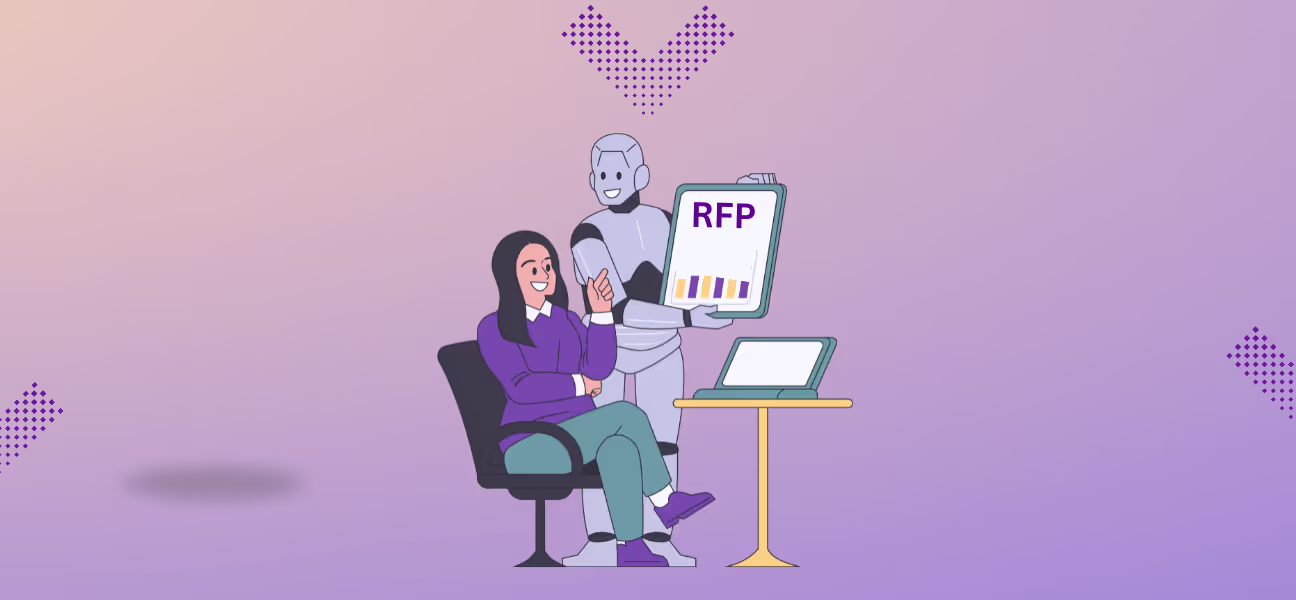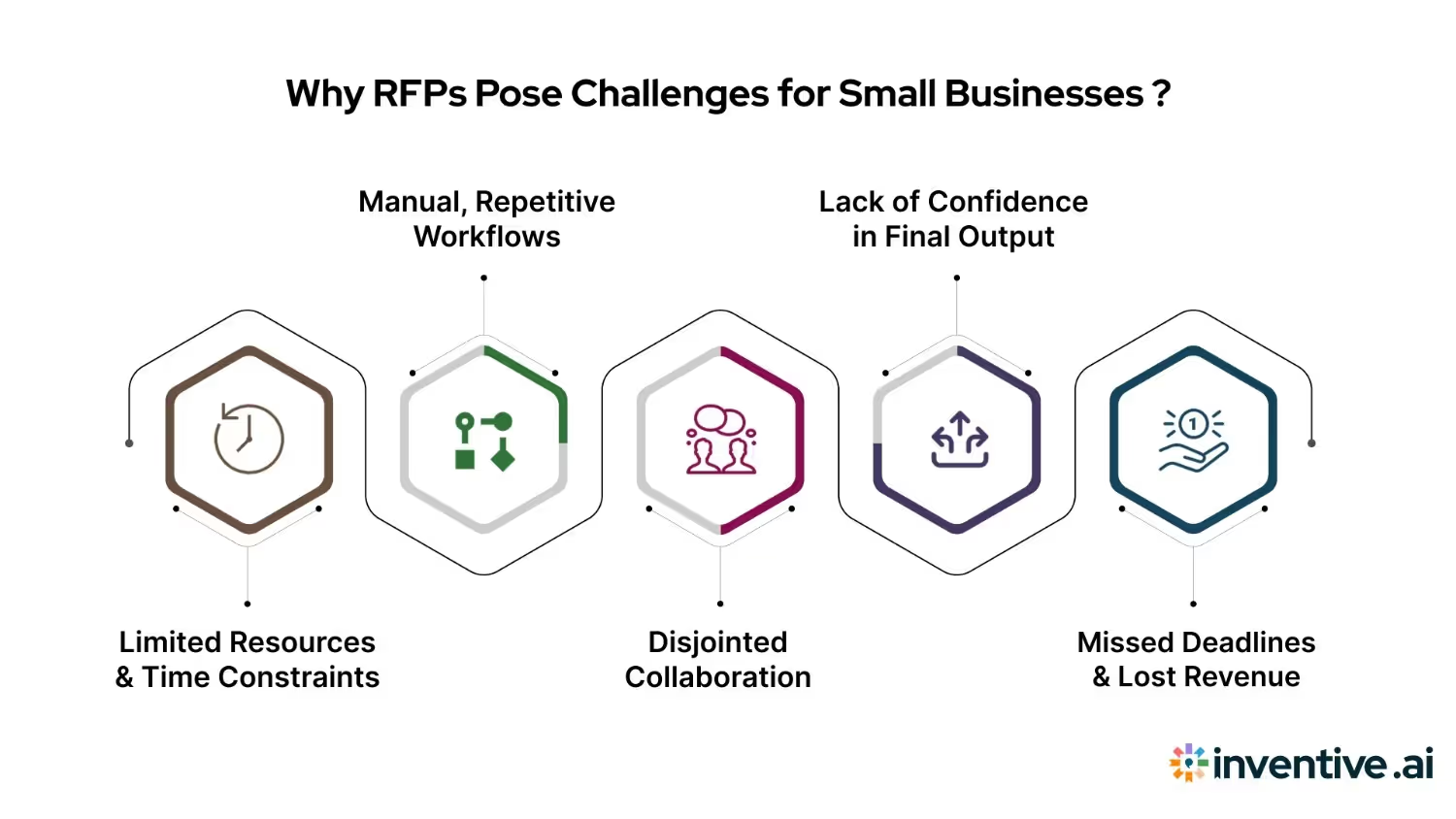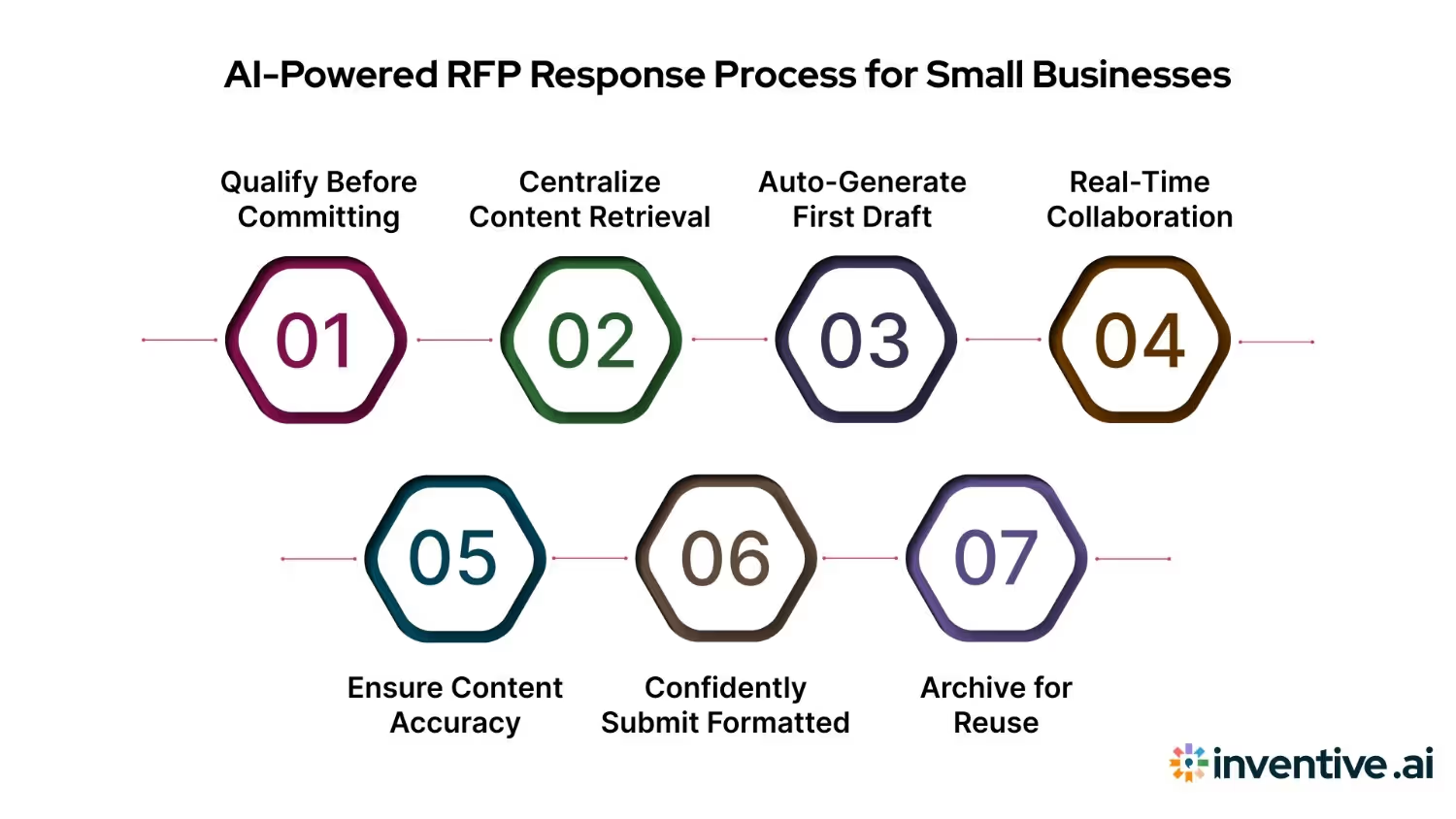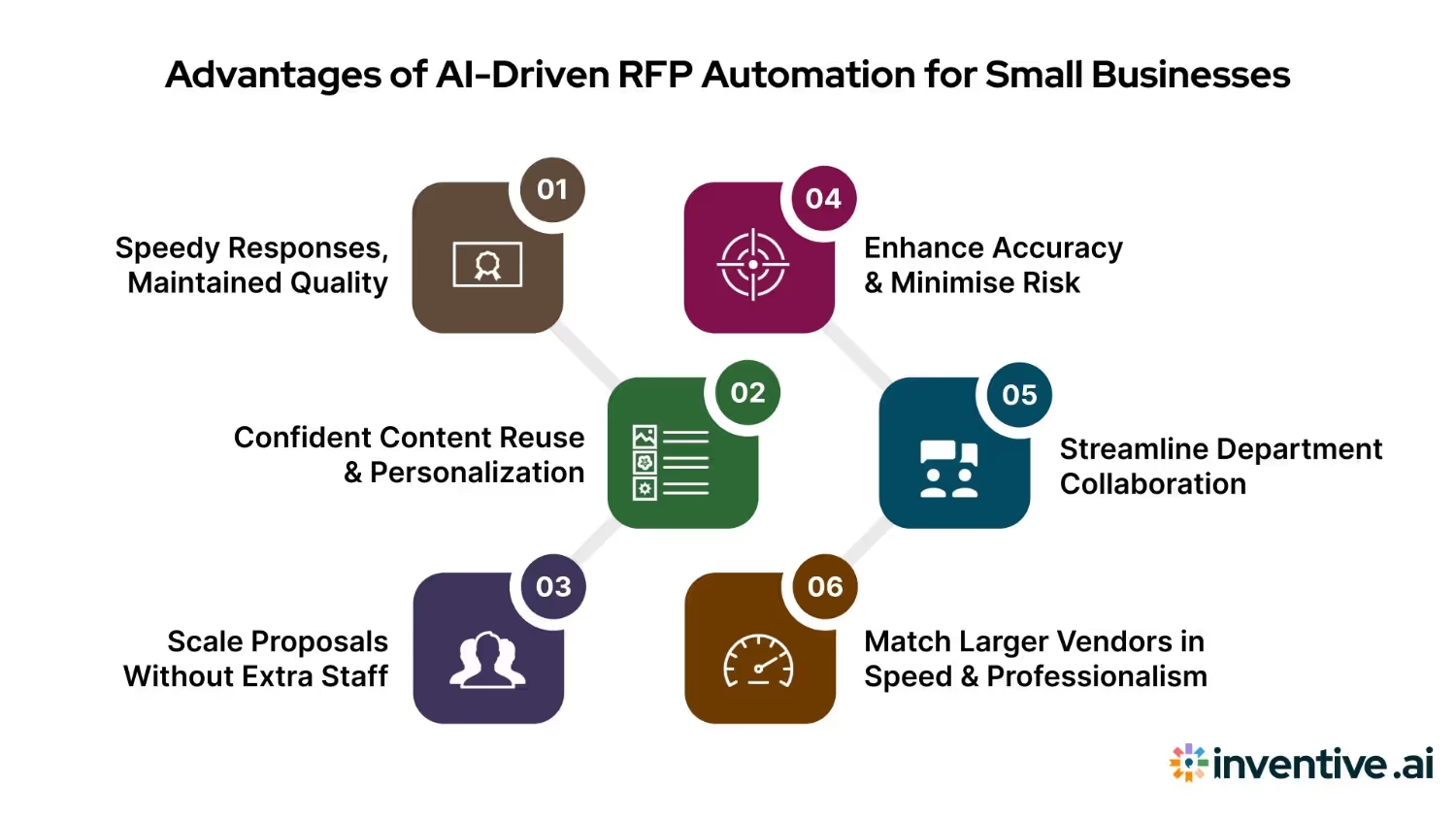AI-Enhanced RFP Proposal Guide for Small Businesses
Boost your RFP success rates with our AI-driven guide. Discover benefits for small businesses and explore AI features. Invest in smarter proposals now!

Introduction
For many small businesses, winning an RFP can unlock significant growth, whether it’s landing a government contract, securing enterprise clients, or entering new markets. But the reality is that most small teams lack dedicated resources for proposal writing, making each RFP feel like a high-pressure marathon against larger, better-equipped competitors.
On average, companies with fewer than 100 employees spend just over 15 hours drafting a single RFP response, compared to 35 hours for enterprise teams, while also involving fewer internal contributors on average. This time pressure, paired with limited bandwidth, means errors, missed deadlines, and poorly formatted proposals become all too common.
Add to that the fact that about 45% of RFPs are completed within 6 to 20 days, with smaller companies often responding quicker, but often sacrificing depth or personalization in the process.
If responding to RFPs feels like a scramble against time and resources, entering more opportunities is often impractical. That’s where AI-driven solutions come in: they let small teams automate repetitive tasks, centralize content, and draft compliant, persuasive responses faster than ever before, without sacrificing quality or accuracy.
In this guide for small business RFP AI implementation, you'll discover how to streamline your workflow, improve consistency, and level the playing field, so you can focus on winning contracts, not chasing documents.
TL;DR
- Responding to RFPs is time-consuming and complex for small businesses, often involving scattered content, manual formatting, and limited proposal bandwidth.
- AI-powered RFP tools automate the response process, helping small teams create accurate, professional proposals in a fraction of the time.
- This guide small business RFP AI adoption walks through common challenges, compares traditional vs. AI-enhanced workflows.
- Key benefits of AI RFP automation include faster response times, 95%+ content accuracy, and up to 3x more proposals submitted, without growing headcount.
- Inventive AI helps small teams win more RFPs by generating draft responses, centralizing content, flagging errors, and enabling real-time collaboration.
Why are RFPs Challenging for Small Businesses?

Small businesses often view RFPs as valuable growth opportunities, but the process of responding can be overwhelming without the right infrastructure.
Here's why:
1. Limited Resources and Time Constraints
Most small businesses don’t have dedicated proposal managers. Instead, proposal writing is often split among sales reps, founders, or operations staff, on top of their regular duties. This leads to delays, rushed responses, or skipping RFPs altogether.
Example: A five-person IT services firm may rely on the sales lead to handle the RFP response, while also managing client demos and onboarding, resulting in a last-minute, underdeveloped submission.
2. Manual, Repetitive Workflows
Without centralized templates or content libraries, teams end up rebuilding the same sections over and over, like company overviews, SLAs, or case studies.
- Copy-pasting from old documents increases the risk of inconsistencies.
- Customizing proposals for each buyer becomes time-consuming and error-prone.
Example: A marketing agency spends over 12 hours reformatting and customizing the same capabilities slide deck for every new RFP.
3. Disjointed Collaboration
Proposal input is typically needed from sales, operations, finance, legal, and technical teams. But small businesses rarely have structured collaboration tools in place.
- Feedback loops are spread across email threads, Google Docs, and last-minute Zoom calls.
- Version control becomes a major problem, teams accidentally overwrite each other’s input.
Example: A freight company loses track of pricing approvals because rate tables were emailed separately and updated in different versions.
4. Lack of Confidence in Final Output
Even if the service is strong, small businesses often worry that their proposal lacks polish, strategic messaging, or competitive positioning.
- Inconsistent formatting or tone across sections weakens credibility.
- Responses may be technically correct but fall short in storytelling or clarity.
Example: A security startup loses a bid to a larger vendor, not because of capability gaps, but because their proposal lacked structure and failed to highlight differentiators clearly.
5. Missed Deadlines and Lost Revenue
With limited bandwidth, small teams often submit RFPs just before the deadline, or miss it entirely. Without automation or reminders, tasks slip through the cracks.
- Late submissions disqualify proposals, no matter how strong the content.
- Frequent bottlenecks erode team morale and reduce win rates.
Why SMBs Need AI RFP Software?
Small businesses often operate with limited staff, tight budgets, and no dedicated proposal team. Responding to RFPs manually takes up valuable time that could be spent on sales or client delivery. AI RFP software solves this by automating repetitive tasks, organizing content, and reducing the effort needed to submit high-quality proposals.
Here are the key reasons -
1. Limited Resources
AI software reduces the burden on small teams by generating first drafts and auto-filling standard sections, helping them respond to more RFPs without hiring.
2. Time Savings
Manual RFP responses can take 15–20 hours. AI cuts this down to 2–4 hours by handling formatting, pulling past responses, and managing version control.
3. Centralized Content Access
Instead of searching through emails or old files, teams can instantly retrieve updated information from a centralized knowledge base.
4. Fewer Errors
AI tools flag outdated content, missing details, and inconsistencies before submission, reducing rework and increasing proposal accuracy.
5. Higher Win Rates
With smarter content suggestions and better alignment to buyer needs, SMBs using AI RFP tools improve their chances of making the shortlist and winning contracts.
For small teams trying to do more with less, AI RFP software is a strategic advantage. Next, let us take a quick look at the differences between traditional vs. AI enhanced RFP workflow.
Traditional vs. AI-Enhanced RFP Workflow: A Comparison Table
For small businesses, the difference between winning and losing an RFP often comes down to efficiency and consistency.
Below is a side-by-side comparison of how the RFP response process typically looks with and without AI support:
To fully grasp the transformation AI brings, it helps to understand what these tools actually do, and why they’re uniquely beneficial for small businesses.
What is an AI-Powered RFP Tool?
An AI-powered RFP tool is software that uses artificial intelligence to help businesses streamline the way they respond to Requests for Proposals. Instead of relying on manual drafting, disconnected files, or outdated templates, AI RFP tools automatically generate draft responses, organize content, and manage collaboration across teams. For small businesses, often working with limited staff and tight deadlines, these platforms can be a game changer.
Unlike traditional proposal tools, AI systems learn from your company’s past responses and documentation. They can identify relevant content, populate sections of an RFP with accurate information, and flag outdated or inconsistent material. Many platforms also integrate with systems like Google Drive, SharePoint, or Slack, allowing users to pull verified content in real time. They support real-time collaboration, assign responsibilities, and ensure version control, so multiple team members can contribute without confusion or delays.
According to a recent Salesforce report, 83% of sales professionals believe that AI helps them spend more time on high-value activities, like closing deals and personalizing proposals. For small teams without dedicated proposal managers, this shift in focus can result in faster submissions, fewer errors, and higher win rates.
In essence, an AI-powered RFP tool acts like a virtual proposal assistant. It accelerates the response process, improves accuracy, and allows even small teams to compete with larger vendors on both speed and quality.
Now that you know what AI RFP tools are, let’s explore how small businesses can use them step-by-step to streamline every stage of the response process.
Step-by-Step: AI-Driven RFP Response Process for Small Businesses

Responding to RFPs can be overwhelming for small businesses. Limited staff, tight deadlines, and a lack of standardized processes often result in rushed or inconsistent submissions. An AI-powered RFP response process gives small teams a structured, repeatable workflow, saving time while improving accuracy and professionalism. Here's how small businesses can implement AI across each stage of the RFP lifecycle:
Step 1: Make a Go/No-Go Decision
Not every RFP deserves your time and resources. Small teams must be strategic in deciding which opportunities to pursue. AI tools can analyze the RFP scope, compare it with historical responses, and surface win-loss patterns to help you make smarter go/no-go decisions.
Example: If a past proposal for a similar government agency resulted in a low score due to pricing misalignment, AI can flag this pattern and recommend deprioritization, saving your team 15–20 hours of wasted effort.
Step 2: Build a Centralized Knowledge Hub
Manually searching through emails, folders, or scattered drives for service descriptions, certifications, or pricing tables is inefficient and error-prone. But with AI RFP automation, you don’t search. The AI finds and suggests the content for you.
Instead of relying on human recall, a centralized knowledge hub allows your AI to automatically retrieve accurate, up-to-date information based on industry, product line, customer type, and more.
Pro Tip: Create a centralized knowledge base by uploading previous RFPs, case studies, SLAs, legal clauses, and pitch decks. Connect your internal systems such as lGoogle Docs, Notion, and SharePoint, to ensure the AI has access to your most valuable content from day one. This foundation enables instant, context-aware suggestions in future responses.
Step 3: Generate the First Draft Automatically
Instead of writing from a blank page, AI tools generate a contextual first draft using your verified knowledge base. This includes boilerplate responses, product specs, compliance statements, and more, all tailored to the specific language of the RFP.
Example: A cybersecurity startup can auto-fill 99% of its RFP draft, including sections on encryption protocols and incident response, if information is available. This helps reduce turnaround time.
Step 4: Collaborate with Internal Stakeholders in Real Time
RFP responses typically require input from multiple departments, sales, pricing, operations, legal, and sometimes IT. AI RFP tools offer a shared workspace where responsibilities can be assigned, approvals tracked, and feedback provided in real time.
No more chasing down edits over email or losing track of which document version is final. Everyone works from one source of truth, with visibility into their section and deadlines.
Step 5: Validate Content for Accuracy and Compliance
Before submission, it's critical to review the proposal for outdated references, missing certifications, or conflicting statements. AI tools act as a second set of eyes, flagging discrepancies and highlighting sections that may need review based on content confidence scoring.
Example: If your fleet capacity changed since your last proposal, the AI will identify that a response referencing your old metrics is likely out of date, and alert you to update it before submission.
Step 6: Format and Submit with Confidence
AI tools help you conform to submission requirements automatically, whether that’s formatting in Word or Excel, combining multiple PDFs, or meeting buyer-specific templates. Some platforms even provide submission checklists to ensure no required sections or attachments are missed.
Pro Tip: Submit at least 24 hours early. AI platforms can set automated reminders to avoid last-minute bottlenecks.
Step 7: Archive and Reuse for Future Proposals
Once submitted, your proposal and all related materials are archived and indexed for future use. This growing library of responses becomes more valuable over time, allowing AI to improve recommendations and reduce manual effort with every new RFP.
Example: The next time you respond to an RFP from a healthcare buyer, the system will suggest specific case studies, compliance language, and win themes from your previous successful submissions in the same sector.
For small teams handling multiple roles, this AI-driven process brings consistency, reduces manual effort, and dramatically improves response quality. What once took 20+ hours and a team-wide scramble can now be completed in a fraction of the time, with fewer errors and more strategic focus.
This repeatable, AI-supported process not only improves speed and quality, it unlocks real business benefits that make small teams more competitive than ever.
Benefits of AI-Powered RFP Automation for Small Businesses

For small businesses, responding to RFPs often means stretching already limited resources, forcing founders, sales leads, or operations managers to juggle proposal writing with their core responsibilities. AI-powered RFP automation transforms this process by reducing manual effort, improving accuracy, and enabling small teams to compete effectively with larger vendors.
1. Respond Faster Without Sacrificing Quality
Time is a major constraint for small teams. AI significantly cuts down the hours spent creating each response by auto-generating drafts using your verified content library. This allows your team to meet tight deadlines without cutting corners or rushing through formatting and compliance requirements.
Example: A five-person logistics startup was able to reduce average proposal preparation time from 15 hours to just 3 hours using AI to auto-fill standard content and accelerate internal approvals.
2. Reuse and Personalize Content with Confidence
AI tools organize and tag past responses by topic, industry, or customer type. Instead of rewriting every answer from scratch, you can reuse high-performing content while tailoring key sections to reflect the unique needs of each buyer, preserving both efficiency and personalization. This ensures your proposals feel custom-built without requiring hours of manual work.
3. Increase Proposal Volume Without Growing Headcount
One of the biggest advantages of automation is scalability. With AI handling repetitive tasks like formatting, content retrieval, and basic compliance checks, your team can submit more proposals each month, without hiring additional staff or working late nights. For small businesses pursuing government, healthcare, or enterprise contracts, this increased capacity directly translates into higher revenue potential.
4. Improve Proposal Accuracy and Reduce Risk
Mistakes in pricing tables, outdated references, or missing attachments can disqualify a proposal, even if your services are a perfect fit. AI-powered platforms flag inconsistencies, detect stale content, and ensure you're using the latest approved data in every response. This minimizes costly errors and gives your team greater confidence in the final submission.
5. Simplify Collaboration Across Departments
Even small teams require cross-functional input, whether it’s legal reviewing terms, operations contributing timelines, or finance approving pricing. AI RFP tools offer shared workspaces with real-time commenting, version tracking, and role-based permissions, so everyone can contribute without confusion or duplication. This clarity reduces bottlenecks and keeps proposals moving forward smoothly.
6. Compete with Larger Vendors on Speed and Professionalism
Buyers judge proposals not just on content, but also on structure, clarity, and attention to detail. AI ensures your formatting is consistent, language is polished, and the overall proposal meets professional standards, helping small businesses present themselves with the confidence and credibility of a much larger organization.
To see how all these benefits come together in real-world scenarios, let’s take a closer look at how Inventive AI helps small businesses win more RFPs with fewer resources.
How Inventive AI Helps Small Businesses Win More RFPs?
For many small businesses, responding to RFPs is a manual, time-consuming process. Without a dedicated proposal team or centralized content, each response turns into a scramble, searching through documents, emailing internal stakeholders, and trying to meet fast-approaching deadlines. The result? Burnout, missed opportunities, and lower win rates.
Inventive AI’s AI RFP Agent is purpose-built to help small businesses respond faster and smarter. Instead of building proposals from scratch, small teams can auto-generate accurate first drafts using verified, reusable content.
1. Save 15+ Hours Per RFP and Focus on Winning, Not Formatting
Small teams often spend up to 20 hours manually building proposals, wasting time on repetitive copy-paste work. With Inventive AI, you get structured, customized first drafts instantly, pulled from your own verified content like rate cards, service descriptions, and certifications. That means your team can focus on strategy and personalization instead of document assembly.
2. Stop Searching and Start Responding. All Content in One Place
No more digging through old folders or chasing files from teammates. Inventive AI gives your team a centralized knowledge hub where every approved case study, technical response, and pricing sheet is searchable and ready to use. A two-person SaaS team used this system to reduce prep time by 75%, responding faster without compromising quality.
3. Reduce Errors and Rework with Built-In Accuracy Checks
Outdated numbers, missing certifications, and inconsistent messaging can cost you the deal. Inventive AI automatically flags these issues before submission, so your team catches problems early. The result? Teams report 95%+ accuracy across AI-generated responses and dramatically fewer last-minute revisions.
4. Submit More Proposals Without Expanding Your Team
When small teams rely on email and scattered docs, collaboration slows down and limits how many RFPs they can handle. Inventive AI creates a shared, role-based workspace with real-time commenting and task tracking. Businesses using this system have seen up an increase in proposal throughput, without hiring.
5. Use What Works. Automatically Surface High-Converting Content
Not sure what to highlight in your next proposal? Inventive AI identifies your most persuasive win themes based on past wins, customer conversations, and internal notes. One marketing agency used this insight to double their shortlist rate by aligning messaging with what buyers cared most about, like “speed-to-delivery” and “multi-platform compatibility.”
Curious how much more you could achieve with your current team? Try our interactive ROI Calculator to see how many more RFPs your team could submit, and win, without growing headcount.
Here’s why it matters to small business teams -
- Respond to RFPs up to 90% faster, even with a lean team. No need to start from scratch every time.
- Eliminate repetitive formatting and content searching that drains time and delays submissions.
- Work seamlessly across sales, founders, and subject matter experts using one shared, real-time workspace.
- Maintain consistency in pricing, compliance, case studies, and messaging across every proposal.
- Scale your proposal volume by 2x–3x without increasing headcount or adding operational overhead.
Conclusion
For small businesses, RFPs represent a chance to break into new markets, win enterprise clients, or secure long-term contracts, but only if your team can respond quickly, accurately, and with impact. Manual workflows, scattered content, and stretched teams make this harder than it needs to be.
AI-powered RFP automation changes that. With tools like Inventive AI, small businesses can reclaim hours of lost time, improve proposal quality, and scale their RFP efforts, without increasing headcount. You don’t need a full proposal department to submit polished, persuasive, and on-time responses. You just need the right system.
If you’re ready to stop scrambling and start winning more, it’s time to reimagine how your team handles RFPs.
FAQs
1. Is AI-generated content secure and compliant for industries like healthcare or government?
Yes. Inventive AI pulls only from your verified internal sources, like compliance documents, certifications, and legal-approved content. For industries with strict regulations, this ensures that responses meet security and audit requirements while avoiding accidental misstatements or omissions.
2. What if my small business doesn’t have a strong content library to start with?
That’s not a problem. Inventive AI learns from what you already have such as proposals, sales decks, security docs, and more, and helps you build a reusable content library over time. Even with just a few quality submissions, the system becomes smarter with every RFP you respond to.
3. Can AI really reflect our brand voice or personalize content for different clients?
Yes. Inventive AI doesn’t just fill in templates. It adapts based on context, tone, and historical wins. You can review and fine-tune every draft to ensure that your messaging sounds like you while still saving time on structure and repetitive sections.
4. How long does it take to get started with Inventive AI?
Most small teams can onboard in less than a week. There’s no complex setup or training required. You can upload existing documents, tag key content, and begin generating draft responses almost immediately, seeing real value from your first RFP.


